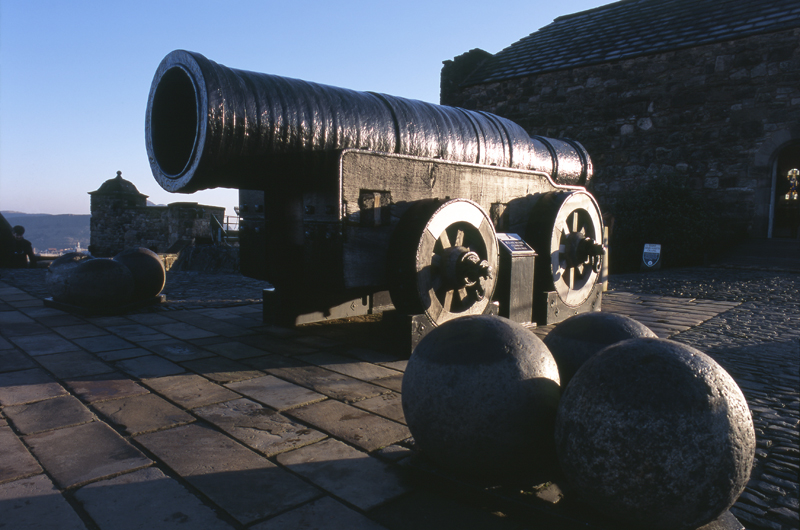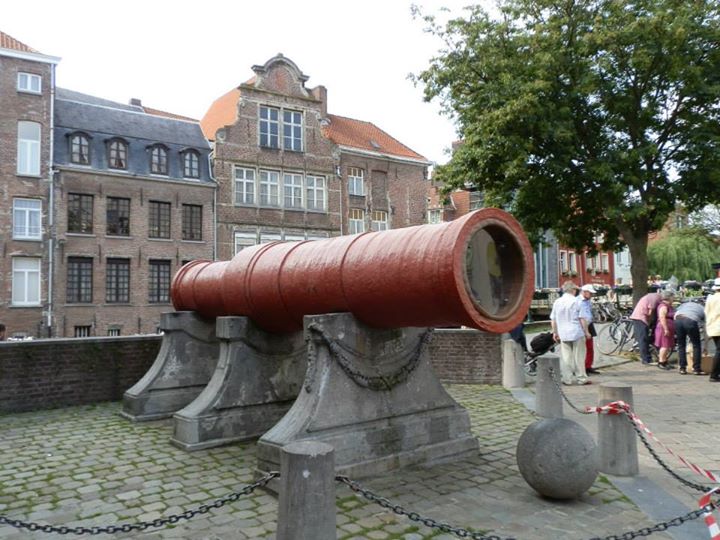Guns and Gunpowder in Late Medieval Scotland: Influences from Flanders
Among the materials that came to Scotland across the North Sea from Flanders in the medieval period were munitions of various types. In this extract from the November/December 2015 edition of History Scotland magazine, available now from www.celebrate-scotland.co.uk, Morvern French describes some of the most notable instances of this type of import.
The Early History of Gunpowder
The first known mention of gunpowder is in the Wujing Zongyao (Collection of the Most Important Military Techniques), a Chinese treatise written in 1044 detailing a substance used to propel incendiary and explosive bombs. Knowledge of gunpowder weaponry was probably transmitted to Europe through the Islamic world, which knew gunpowder as ‘Chinese snow’ or ‘Chinese salt’.
The first European recipe for gunpowder is believed to be that of Roger Bacon, in his Epistola de secretis operibus artis et naturae, et de nullitate magiae (Letter on the Secret Workings of Art and Nature, and on the Vanity of Magic) of the mid-13th century. In it Bacon revealed that one should take seven parts of saltpetre, five of charcoal, and five of sulphur, ‘and thus you can make thunder and lightning, if you know the means’.
Soldiers of high rank were at first sceptical of this new technology as it brought them into greater danger of death than had traditional weapons. Expensive plate armour was no protection against gunfire, and the advantages of social status on the battlefield were effectively swept away. Nobles were much less likely to be spared in exchange for a ransom payment, and instead could be killed or wounded by an anonymous enemy gunner.
Flemish Munitions in Scotland
By around 1400 guns were used in nearly every European military engagement, at both battles and sieges, eventually coming to replace archery as the primary artillery weapon. The most significant early use of guns by the Scottish army was at James I’s unsuccessful siege of English-held Roxburgh in 1436, for which he ordered the purchase of bombards and aliis instrumentis et apparatibus bellicis (other instruments and equipment for war), and hired specialist gunners and artillery workers from Germany.
James is likely to have used at Roxburgh the brass bombard brought to him from Flanders in 1430, which contemporary chronicler Walter Bower recorded as bearing the following inscription:
For the illustrious James, worthy prince of the Scots.
Magnificent king, when I sound off, I reduce castles.
I was made at his order; therefore I am called ‘Lion’.
Bombards were large cannon (from the Greek kanun or the Latin canna, meaning ‘tube’) measuring as much as 5.2m in length and weighing as much as 16,400kg. They fired stone cannonballs weighing up to 386kg. Although today we might think of ‘cannon’ as a synonym of ‘bombard’, the word in fact applied to all gunpowder weapons, as did the word ‘gun’.
An account of the Burgundian siege of the French city of Bourges in 1412 gives us an idea of the destructive potential of bombards. The attackers…
…caused a cannon called Griette, which was bigger than the others, to be mounted opposite the main gate. It shot stones of enormous weight at the cost of large quantities of gunpowder and much hard and dangerous work on the part of its expert crew. Nearly twenty men were required to handle it. When it was fired the thunderous noise could be heard four miles away and terrorised the local inhabitants as if it were some reverberation from hell. On the first day, the foundations of one of the towers were partially demolished by a direct hit. On the next day this cannon fired twelve stones, two of which penetrated the tower, thus exposing many of the buildings and their inhabitants.
The weaponry holdings of the Scottish monarchy were upgraded substantially upon the marriage of James II to Mary of Guelders, daughter of Arnold, duke of Guelders and great-niece of Philip the Good, Duke of Burgundy and Count of Flanders, at Holyrood on 3 July 1449. The Treaty of Brussels outlining the alliance with Burgundy bound the parties to assist each other against aggressors, for which Mary’s dowry would come in very useful. Philip arranged for a large collection of weaponry, five galleys worth, from his own arsenal to be sent to James via Antwerp. The Burgundian territories of the Low Countries were considered a European centre for the production of gunpowder weaponry, as well as a major entrepôt for the redistribution of guns and their paraphernalia. Much of the saltpetre imported into Scotland, for example, would have come from the Baltic states via Bruges or Antwerp.

The details of the ducal weaponry gift still survive in the form of a list written by Berthelot Lambin, controller of Philip the Good’s artillery, preserved in the Archives de la Côte-d’Or. The inventory lists artillery pieces such as 22 veuglaires de fer et 64 chambres pour lesdiz veuglaires (22 iron veuglaires and 64 chambers for those veuglaires), 46 coulevrines de fer (46 iron culverins), as well as powder and stone shot for their use.
Veuglaires were medium-sized cannon which were generally between 1.22 and 1.83m in length, which varied widely between 48 and 3,584kg in weight, and which fired stone cannonballs of between 1 and 14.5kg. Such medium-sized weapons would eventually become the most common type of non-hand-held type of gun in the early modern army, as they were used for both sieges and battles.
Culverins were the smallest type of gun, measuring from 15 to 122cm in length, weighing between 6 and 23kg, and firing lead instead of stone balls. The culverin was the original hand-held gun, and its use was limited to the battlefield. The Burgundian ducal arsenal was one of the most advanced in Europe, as shown by the inclusion of this type of gun. They were much easier to transport than were larger artillery weapons and were more effective in battle, so much so that later in the 15th century it became mandatory for every Burgundian army unit of 8,400 men to contain 600 coulevriniers.
In 1457 there appeared in Scotland from Burgundy the great bombard Mons Meg, now on display at Edinburgh Castle. With an overall length of 4.04m and a weight of 6,040kg, Mons Meg is remarkably similar to the Flemish bombard Dulle Griet, the largest complete surviving bombard in the world, now in Ghent. The two cannon are of similar dimensions and of the same construction, both being of wrought iron bars welded and held together by iron rings, and with a three-stepped ring at the muzzle. All of these elements point to a strong case for Mons Meg and Dulle Griet being made by the same manufacturer: Jehan Cambier, the artillery maker of the duke of Burgundy.

Although powerful siege weapons, bombards were difficult to transport, liable to become bogged down, laborious to load due to the large projectiles and amounts of gunpowder required, and they took a long time to cool down before reloading. They also had a tendency to fracture and burst, or to be destroyed by enemy fire. Although large bombards remained in use, from the mid-15th century they began to be replaced by smaller, often hand-held, weapons.
Gret dolour throu all Scotland
James II was killed at the siege of Roxburgh after one of his own cannon exploded near him. 16th century historian Robert Lindsay of Pitscottie wrote that James was so heartened by the arrival of the earl of Huntly that he ordered his gunners to discharge a volley, and a fragment from the broken gun severed the king’s thigh bone, causing him to die from blood loss. In the Auchinleck Chronicle it is recorded that James ‘unhappely was slane with ane gun the quhilk brak in the fyring / for the quhilk was gret dolour throu all Scotland’. Despite the king’s unfortunate demise, his forces succeeded in taking Roxburgh Castle.
By the end of the 15th century guns had made redundant the type of weaponry traditionally viewed as ‘medieval’: swords, bows and arrows, and even plate armour. Guns had come to be an essential part of military readiness. Acts of Parliament in 1535 and 1540 ruled that those with land valued at £40 were to own one culverin, and those with land valued at 100 marks (a mark being 2/3 of a pound) were to have two. Those affected were also required to possess the necessary powder, bullets, and men capable of using the guns. Early arguments against the lethal potential of guns had largely diminished as European rulers competed with each other to maintain the most impressive arsenals as symbols of their power, often looking to Flanders as the source of their weaponry.
Morvern is a third year PhD student at the University of St Andrews and a contributor to the Scotland and the Flemish People project.
Further Reading
David H. Caldwell (ed.), Scottish Weapons and Fortifications, 1100-1800 (Edinburgh, 1981)
Kelly DeVries, Guns and Men in Medieval Europe, 1200-1500: Studies in Military History and Technology (Aldershot, 2002)
Kelly DeVries, Medieval Military Technology (Peterborough, ON, 1992)
Katie Stevenson, Chivalry and Knighthood in Scotland, 1424-1513 (Woodbridge, 2006)